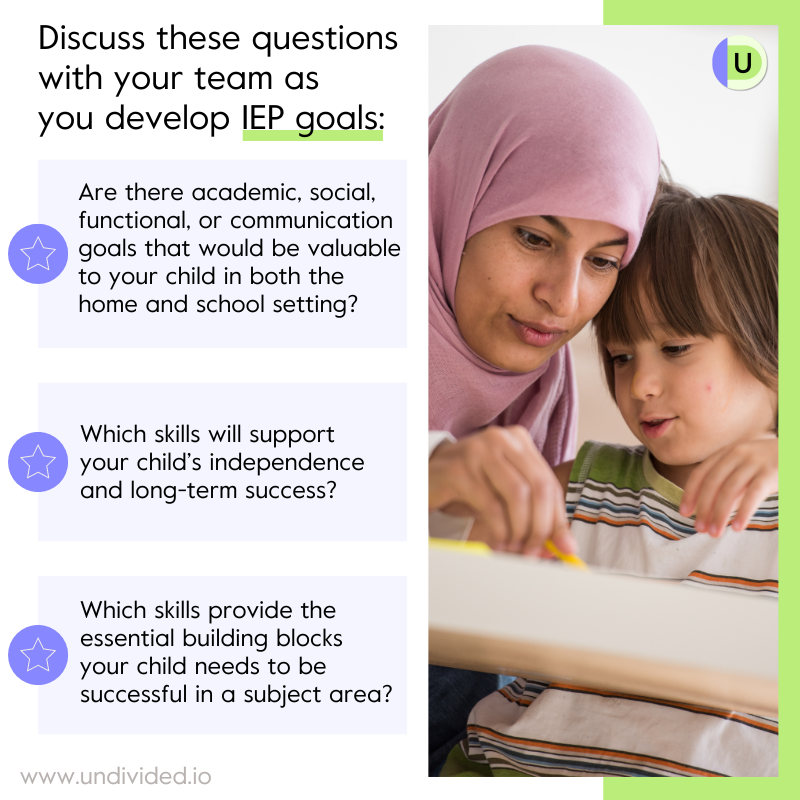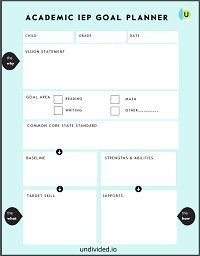A Parent's Guide to IEP Goals
Whether they are academic, behavioral, functional, social, or communication-based, IEP goals are one of the most important parts of a student’s IEP. There are several reasons for this. Goals — and your child’s progress in meeting them — are the tools we use to measure the effectiveness of their IEP. Goals also prioritize the specific skills that your child needs to access the general education curriculum. Finally, goals are the framework that support a child’s placement and services, so they should be appropriately challenging and aligned with a student’s strengths, needs, and interests.
So how do we write strong IEP goals that do all that and more? We sat down with Dr. Caitlin Solone — education advocate, teacher educator, and faculty at UCLA — to talk through the legal requirements, SMART goals, vision statements, and lots more.
3 key takeaways
- IEP goals prioritize the skills that your child needs to access the general education curriculum.
- IEP goals should be aligned with the state standards for your child's grade level.
- Good IEP goals include the time frame, condition, skill, supports, evaluation criteria, and measurement method.
What does the law say about IEP goals?
The Individuals with Disabilities Education Act, or IDEA, says that all IEPs must contain the following:
- A statement of measurable annual goals, including academic and functional goals that are designed to meet the student’s needs resulting from their disability so they can be involved in the general curriculum and make progress in their studies, and meet each of the student’s other educational needs resulting from their disability. Students who take alternate assessments should also have a description of benchmarks or short-term objectives written into each goal.
- A description of how a student’s progress toward meeting their annual goals will be measured, and when parents will be provided with periodic reports on the student’s progress toward meeting their annual goals. For example, this can be done through the use of quarterly reports in addition to report cards.
Before a student’s 16th birthday, IDEA also requires that an IEP include postsecondary goals as part of their Individual Transition Plan. You can read much more about that in our article Individual Transition Plan (ITP) 101.
How are IEP goals determined?
1. Parent input
Your input as a parent is incredibly valuable when it comes to determining which skills to prioritize. Here are some of the questions you should be prepared to discuss at the IEP meeting:

If you aren’t asked to provide input during the meeting, you can reach out to your IEP team to let them know that you’d like to contribute to developing your child’s IEP goals. You are an integral part of the IEP team, after all.
2. Identification of needs
Typically, any performance area (such as math, reading, speech, social skills, etc.) with identified needs in the Present Levels of Performance (PLOP) section of your child’s IEP should be addressed with an IEP goal.
For example, if the IEP team has identified math skills that your child needs to work on, there should be at least one goal for math written into their IEP.
3. State Standards
All special education students must have academic goals written into their IEP that are aligned with the state standards for their grade level. The majority of states use the Common Core State Standards (CCSS); you can check whether your state uses CCSS here. You can find Common Core State Standards for grades K–12 here: English Language Arts and Math.
By developing goals that follow educational standards for all students, we make it possible for our children to attain the same skills as their peers. Aligning IEP goals with the general education curriculum also supports access to an inclusive environment, if that’s the right place for them to learn. In specialized classrooms, students should also be working on grade-level content. Aligning goals with the state standards can help to ensure that progress is made in a multi-grade classroom.
Regardless of what subject you’re focusing on, the goal-writing process remains the same: You’ll individualize each standard to fit your child, then add in the prompts, options, modifications, and accommodations that will help your child achieve that standard. If your child has more significant support needs, you should still follow the state standards to guide IEP goal development.
What does an IEP goal look like?
Before working on IEP goals, it's important to know what a goal looks like. IEP goals contain six parts:

- Time frame: by what date should the IEP goal be met?
- The time frame is usually one year for an annual goal. It may be specified in the number of weeks, or a certain date for completion.
- Condition: what conditions need to be met for the student to meet this goal?
- The condition can include a variety of information depending on what skill the goal is targeting, such as environment or setting, related service or supports, specific situations/scenarios, etc.
- Skill: what specific skill should the student master in the time frame?
- It may help to think of the skill as something actionable that you can see, hear, and measure, often with a specific behavior listed in the goal. This can include practicing self-advocacy skills by using behaviors such as “will ask for a break by raising their hand” or “by practicing deep breathing exercises.”
- Supports: what kind of support can the student receive to meet this goal?
- What will help your child be successful with the target skill? This can be where you specify accommodations or modifications, and can look like “by using a magnifier or large-print materials.”
- Accuracy/Evaluation Criteria: how accurate does the student need to be to demonstrate mastery of the goal?
- Evaluation criteria can be measured by accuracy, frequency, or consistency: how much, how often, or to what standards the behavior must follow to demonstrate the goal has been met.
- Evaluation/Measurement: how will the student's performance be measured?
- This is how the data will be collected on the IEP goal to determine whether or not the IEP goal was met. Evaluation can include observations, permanent products, recorded data, and more.
Dr. Solone provided us with an IEP goal formula template that you can use to help you identify all the parts of IEP goals.
How do I write appropriately challenging IEP goals?
Start by using a goal-planning template
Dr. Solone provided us with academic and non-academic goal planner templates that you can use to help you create strong IEP goals for your child. These goal-planning templates separate various aspects into different sections so that you can hone in on and personalize each part of a goal. They take you through each of the steps described below, from writing a vision statement to identifying the goal and the state standard associated with it to identifying your child’s strengths and abilities and the types of supports and accommodations they will need.
Visit this page for Undivided members to download the full template.
We’ll walk you through each of these steps below. Remember:
- When you’re lost, circle back to what your child can do.
- Start at the baseline for a targeted skill and build from there.
- Use your child’s strengths to carve a path for them.
- Focus on the supports/prompts/accommodations/modifications that can allow your child to access that goal.
- Alter your perspective and mindset: We’re changing “My child can’t” into “How can we make this possible?”
- Don’t let yourself become overwhelmed by state standards, goal framework, and other particulars. Instead, think back to your vision statement. What do you imagine for your child’s future? What are you working to include in your child’s IEP right now?
Create a vision statement & take a strength-based approach
Dr. Solone believes that the first step parents can take toward a strong IEP is to create a vision statement — in other words, write down what we want out of life for our child, and what our child wants out of life for themselves. Taking a little time to identify a vision for your child can help you — and the IEP team — consider each goal and objective as a stepping stone, and each service and support as a guidepost. Learn how here: Creating a Vision Statement for Your Child.
Beginning with a vision statement can help you make sure your child’s IEP goals are clear, specific, measurable, and appropriate for them. For IEP goals to be appropriate, Dr. Solone explains that IEP teams need to “presume competence” in a student — in other words, IEP goals should be written from a strength-based perspective. (Read more about strength-based IEPs here!)
When IEP teams focus on the whole child, that child’s abilities and strengths are utilized to help the child master the goal, rather than assuming the child can’t master it because they have nontypical ways of communicating, moving, expressing, learning, or existing in the world. For example, if a student — say, Joshua — can’t comprehend grade-level text because a learning disability impacts his ability to read at grade level, Joshua’s comprehension goal can allow for text-to-speech software to read to him. In order to develop strength-based IEP goals, we have to think creatively about solutions that will allow our kids to meet an education goal.
Use the state standards
If your child has more significant support needs, you should still follow the state standards to guide IEP goal development. If your state uses the Common Core State Standards, then you can reference the Core Content Connectors and Essential Understandings, which were created to help children who use modified curriculum or take alternate assessments to access the core curriculum. As Dr. Solone explains, “Core Content Connectors connect you from the Essential Understanding to the Common Core standard as a bridge.”
Dr. Solone suggests focusing on these specific questions when you’re creating a standards-based goal using the Common Core State Standards:
What do you want your child to do? (And why do you want them to do it?)
- Answering this question helps you identify the skill you want your child to learn. To do this, consider your child’s Present Levels of Performance (PLOPs) — what skills have they learned or mastered already? What skills do they still need to learn?
- Look at CCSS for the specific subject — you can use these Element Cards to identify the skill you want to focus on. Which standards reflect skills that will help your child realize your/their vision for the future?
- First, look at the task or skill described in the Essential Understandings column. Ask yourself, can my child do this already?
- If the answer is yes, go to the task or skill described in the Core Content Connectors column. Ask yourself the same question: Can my child do this already?
- If the answer is yes, go to the task or skill described in the CCSS column.
- Once you discern which parts of a state standard your child can already do, then you can narrow down what skill they need to work on.
What supports will enable your child to meet this goal?
Here is where you’ll specify the accommodations or modifications that will allow your child to complete these tasks — whether that’s asking for multiple choice assignments, prompts, an AAC device, the text-to-speech software mentioned in a previous example, etc.
How will you know if your child has met the goal?
This is all about finding ways to measure your child’s progress — whether that’s teacher-charted data, observation, specific assessment data, work samples, etc. Keep in mind that an IEP cannot have goals that cover all grade-level standards — there are simply too many! Therefore, parents should think about which standards are essential and which skills will be the most beneficial for their student’s future.
- A student will typically have one to three IEP goals for each performance area with an indicated need.
- IEPs usually have anywhere from one to twenty goals, depending on the student’s needs and the number of services the student receives.
- To help you narrow it down, ask your child’s teacher for input — collaborating on which goals will be most meaningful and important for your child is ideal.
Work with your child’s teacher
Here’s an example of what a conversation about a particular goal might look like:
A teacher tells you that the following math standard will be addressed throughout the year: Number & Operations in Base Ten: 3.NBT.A.2: Fluently add and subtract within 1000 using strategies and algorithms based on place value, properties of operations, and/or the relationship between addition and subtraction.
You believe that your child would benefit greatly from learning to do this, but you recognize that the current standard is beyond your child’s abilities at this moment in time. You then look to the Core Content Connector, which states: 3.NO.2c1 Solve multi-step addition and subtraction problems up to 100.
You also note the Essential Understanding (a.k.a., the most essential or fundamental skill that can be acquired in relation to this standard) in the Core Content Connector, which states: Combine (+) or decompose (-) with concrete objects; use counting to get the answers.
From there, you consider your child’s capabilities and determine that your child has recently mastered addition or combining concrete objects, but you would really like them to learn how to decompose or subtract a particular number of objects to get an answer. You feel this would be helpful at home for various reasons, and you feel it is a skill your child will need throughout their life, so you decide you’d like to write an IEP goal to address this skill.
Here’s how the IEP goal would be written: When presented with up to 20 objects and asked to take away or subtract a number 1–20, [STUDENT] will remove the quantity requested and will count the remaining objects to determine the number of objects left with 80% accuracy (e.g., 4 out of 5 opportunities) in 4 out of 5 trials across 2 consecutive weeks as measured by teacher charted data and student work samples.
Write new Individualized Education Program (IEP) goals
6 common myths about IEP goals
Myth: IEP goals must come from the school district’s IEP goal bank.
If a district or school has access to an IEP goal bank, this is not the norm, nor is it a comprehensive list of IEP goals available to students receiving special education services. IEP goals should be developed based on the individual student’s needs, which may align with goals offered in the goal bank, and may not. Therefore, there is no requirement that the goal must come from an IEP goal bank. While some goals found in goal banks are clear, measurable, and aligned with grade-level standards, IEP teams can develop unique goals to match the unique needs of the student.
Myth: If my child doesn’t meet an IEP goal, the goal should be on the IEP the following year.
When your child doesn’t meet an IEP goal, simply rolling the goal over to the following year’s IEP is not sufficient. Instead, it’s important to think about why your child didn’t meet the goal. Are there other skills your child needs to learn in order to meet the goal that should be addressed first? What supports would benefit your child’s mastery of the goal? Is the way the goal is being assessed appropriate or in alignment with the way your child expresses themselves? Is the goal essential for the student to learn, or are there bypass strategies or other ways to accomplish the same thing?
Myth: My child’s IEP goals define their educational program. They are the only thing my child should work on.
IEP goals are only a portion of a child’s education. They are used to demonstrate a student’s progress and provide ways to measure whether the IEP is effective in educating the student. Though IEP goals should be addressed and targeted within the learning each week, they are not the only skills students should be working on over the course of the year.
Myth: Goal objectives or benchmarks are optional.
This is only true for some students. If your child is taking the alternate state assessment or on alternate or modified curriculum, it is required that their IEP goals all have benchmark goals or objectives. For example, for every annual goal, there should be at least two benchmark goals (sometimes called objectives or incremental objectives) that the student would be expected to meet in incremental periods of time (e.g., the first objective in four months and the second in eight months).
Myth: My child’s goals don’t need to be aligned with the general education curriculum if they are performing far below grade level.
It is ideal for all students to have academic goals that are aligned with the state standards or the general education curriculum. For students with more extensive support needs who take the alternate state assessment, it is best practice to use Core Content Connectors or Essential Understandings to determine appropriate goal objectives.
Myth: According to testing, my child is designated as an English Learner (EL), or Limited English Proficient. Because that’s a need, there must be a goal included in the IEP that addresses English language development (ELD).
IDEA requires IEPs to have goals in areas of need that are related to the student’s disability. Because being an English learner is not a disability, it is not required that the student have an English language development goal on their IEP. State and federal regulations do require, however, that IEP goals are linguistically appropriate. This means that the IEP goals must be written in a way that reflects the linguistic ability of the student. A student’s linguistic ability is determined through the English language development assessment.
Join for free
Save your favorite resources and access a custom Roadmap.
Get StartedAuthor





